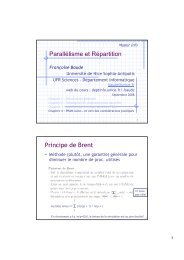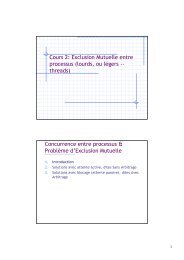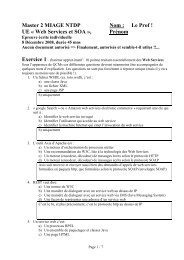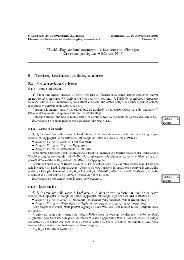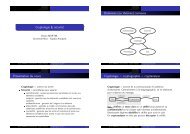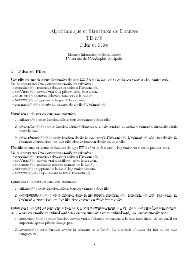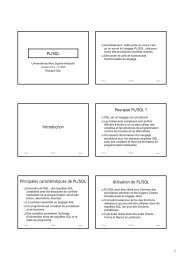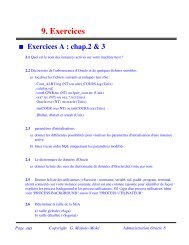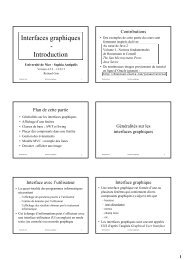TikZ and pgf
TikZ and pgf
TikZ and pgf
You also want an ePaper? Increase the reach of your titles
YUMPU automatically turns print PDFs into web optimized ePapers that Google loves.
3 Tutorial: A Picture for Karl’s Students<br />
This tutorial is intended for new users of <strong>pgf</strong> <strong>and</strong> <strong>TikZ</strong>. It does not give an exhaustive account of all the<br />
features of <strong>TikZ</strong> or <strong>pgf</strong>, just of those that you are likely to use right away.<br />
Karl is a math <strong>and</strong> chemistry high-school teacher. He used to create the graphics in his worksheets <strong>and</strong><br />
exams using L A TEX’s {picture} environment. While the results were acceptable, creating the graphics often<br />
turned out to be a lengthy process. Also, there tended to be problems with lines having slightly wrong angles<br />
<strong>and</strong> circles also seemed to be hard to get right. Naturally, his students could not care less whether the lines<br />
had the exact right angles <strong>and</strong> they find Karl’s exams too difficult no matter how nicely they were drawn.<br />
But Karl was never entirely satisfied with the result.<br />
Karl’s son, who was even less satisfied with the results (he did not have to take the exams, after all),<br />
told Karl that he might wish to try out a new package for creating graphics. A bit confusingly, this package<br />
seems to have two names: First, Karl had to download <strong>and</strong> install a package called <strong>pgf</strong>. Then it turns out<br />
that inside this package there is another package called <strong>TikZ</strong>, which is supposed to st<strong>and</strong> for “<strong>TikZ</strong> ist kein<br />
Zeichenprogramm.” Karl finds this all a bit strange <strong>and</strong> <strong>TikZ</strong> seems to indicate that the package does not<br />
do what he needs. However, having used gnu software for quite some time <strong>and</strong> “gnu not being Unix,” there<br />
seems to be hope yet. His son assures him that <strong>TikZ</strong>’s name is intended to warn people that <strong>TikZ</strong> is not a<br />
program that you can use to draw graphics with your mouse or tablet. Rather, it is more like a “graphics<br />
language.”<br />
3.1 Problem Statement<br />
Karl wants to put a graphic on the next worksheet for his students. He is currently teaching his students<br />
about sine <strong>and</strong> cosine. What he would like to have is something that looks like this (ideally):<br />
y<br />
1<br />
The angle α is 30 ◦ in the example<br />
(π/6 in radians). The sine of α, which<br />
is the height of the red line, is<br />
−1 − 1 2<br />
1<br />
2<br />
α<br />
cos α<br />
sin α<br />
1<br />
tan α = sin α<br />
cos α<br />
x<br />
sin α = 1/2.<br />
By the Theorem of Pythagoras we<br />
have cos 2 α + sin 2 α = 1. Thus the<br />
length of the blue line, which is the<br />
cosine of α, must be<br />
cos α = √ 1 − 1/4 = 1 2√<br />
3.<br />
− 1 2<br />
This shows that tan α, which is the<br />
height of the orange line, is<br />
−1<br />
tan α = sin α<br />
cos α = 1/√ 3.<br />
3.2 Setting up the Environment<br />
In <strong>TikZ</strong>, to draw a picture, at the start of the picture you need to tell TEX or L A TEX that you want to<br />
start a picture. In L A TEX this is done using the environment {tikzpicture}, in plain TEX you just use<br />
\tikzpicture to start the picture <strong>and</strong> \endtikzpicture to end it.<br />
3.2.1 Setting up the Environment in L A TEX<br />
Karl, being a L A TEX user, thus sets up his file as follows:<br />
20






